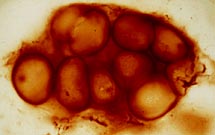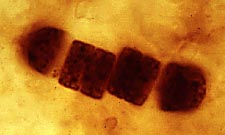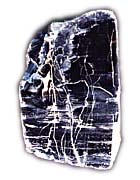


Dating to more than 850 million years old in central Australia, the Bitter Springs Formation contains chert beds which have yielded some of our best and most diverse Proterozoic fossils. These include thirty species of microfossil, with more than a dozen cyanobacteria, a couple of chlorophycean algae, and an assortment of possible fungi, dinoflagellates, and heterotrophic bacteria.
Bitter Springs strata are exposed at the northeastern end of the Amadeus Basin (shown in red in the map above), in central Australia. The formation is composed largely of dark limestone and dolomite, and contains black chalcedonic chert in fine laminated layers, a piece of which is displayed near the bottom of this page. The formation has yielded numerous fossils of stromatolites in addition to microfossils.


Ancient Fossil Bacteria : Pictured above are two kinds cyanobacteria from the Bitter Springs Chert. On the left is a colonial chroococcalean form, probably Myxococcoides minor, and on the right is the filamentous Palaeolyngbya.
The microfossils of Bitter Springs are amazingly well-preserved. Thin sections of fossiliferous chert make it possible to view their three-dimensional morphology (as shown in the pictures above). This exceptional situation is the result of the fine-grained way in which the cherts formed, through chemical precipitation. However, though the fossils are morphologically preserved, infra-red spectroscopy shows that the organic materials have been geochemically altered.
 The Bitter Springs microbiota was one of the earliest successful demonstrations
that fossils could be found in Precambrian rocks, and along with fossils
found in the Gunflint chert of Ontario, Canada, revolutionized thinking about
what evidence of early life might be available to be found. J. William
Schopf, who published the first extraordinary findings from this locality,
attributes this revolution to four factors: widespread attempts to
radiometrically date Precambrian strata; the realization that cherts might
preserve delicate fossils; successful searches for biologically significant
compounds in Precambrian rocks; and the use of electron microscopy.
The Bitter Springs microbiota was one of the earliest successful demonstrations
that fossils could be found in Precambrian rocks, and along with fossils
found in the Gunflint chert of Ontario, Canada, revolutionized thinking about
what evidence of early life might be available to be found. J. William
Schopf, who published the first extraordinary findings from this locality,
attributes this revolution to four factors: widespread attempts to
radiometrically date Precambrian strata; the realization that cherts might
preserve delicate fossils; successful searches for biologically significant
compounds in Precambrian rocks; and the use of electron microscopy.
Fossils from Bitter Springs are also important for two others reasons. First, they show that the cyanobacteria were present in morphologically modern forms, and were quite diverse from an early date. With additional evidence demonstrating that stromatolites are the products of cyanobacterial activity, it is now believed that the cyanobacteria diversified early and spread globally, becoming important players in the history of early life on Earth. The fact that recognizeable forms appear in rocks nearly 1,000 million years old is a remarkable case of morphological conservatism. Perhaps cyanobacteria are simply successful in the forms they acquired early in their evolution, or perhaps they possess some mechanism of genetic stability which has caused them to remain physically unchanged since that time.
Second, and perhaps even more important, it was at Bitter Springs that the first convincing evidence of early eukaryote fossils was found. Some of the larger cells have preserved internal structures comparable to nuclei and pyrenoids, upon which basis they were assigned to the green algae. While it is possible that the inclusions are artifacts of preservation, other lines of evidence, such as molecular sequence data, have established that eukaryotic cells had evolved by this time.


